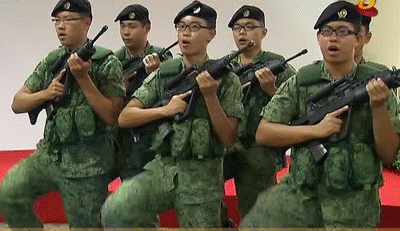Apparently PLA Rocket Force proved that they used real missiles for that Truly Combat Ready Parade by launching half of the ICBM/IRBM after parade. It was declared that troops at that parade was fully armed and in full condition to be committed into a war field as they were during the parade, not just a fake Wayang Parade.
http://thediplomat.com/2017/08/chin...-missile-drill-against-a-thaad-mockup-target/
Chinese People's Liberation Army Rocket Force Staged a Massive Missile Drill Against a THAAD Mockup Target
The exercise came one day before the People’s Liberation Army celebrated its 90th anniversary with a major parade.
By Ankit Panda
August 03, 2017
China’s People’s Liberation Army Rocket Force (PLARF) held a combined massive ballistic and cruise missile exercise over the weekend, one day before a major parade to celebrate the People’s Liberation Army’s 90th anniversary.
The drill, which took place in Inner Mongolia, near the PLA’s Zhurihe military base, involved at least three types of missile systems and the launch of at least 20 missiles.
According to U.S. government sources with knowledge of the exercise who spoke to The Diplomat, the PLARF employed four DF-26C intermediate-range ballistic missiles (IRBM), ten DF-16A medium-range ballistic missiles, and six CJ-10 land attack cruise missiles in the live fire portion of the exercise.
At least three surface-to-air missile systems were involved in the exercise as well, including the HQ-6, HQ-16, and HQ-22. The HQ-22 was seen publicly for the first time at the PLA’s 90th anniversary parade.
The ballistic and cruise missiles simulated a long-range strike on a mock up of a U.S. Terminal High Altitude Area Defense (THAAD) site and also struck ground-based models of U.S. F-22 Raptor stealth fighters, one source added.
The exercise is one of the largest recent PLARF exercises of its kind and one of the first publicly reported uses of the DF-26C IRBM in an exercise. Little public information exists on the DF-26C, which is a secretive PLARF IRBM capable of precision strikes with both conventional and nuclear payloads and is thought to have been first deployed in 2014 or earlier.
The DF-16 MRBM is also a secretive program, with the missiles having first been displayed publicly at China’s September 2015 parade to commemorate the 70th anniversary of the end of the Second World War.
Earlier this year, new images of the DF-16, including never-before-seen configurations, appeared on several Chinese websites. The MRBM serves a conventional payload precision-strike role with a range in excess of 1,000 kilometers and at least three known variants exist.
The CJ-10, meanwhile, is a standoff cruise missile, capable of striking targets at a range in excess of 1,500 kilometers, according to U.S. Department of Defense’s 2017 report on China’s military capabilities.
Combined, the exercise likely tested the PLARF’s ability to stage a coordinated precision-strike salvo attack against defensive installations like a THAAD battery across multiple missile crews.
A single THAAD battery, while effective against short-, medium-, and intermediate-range incoming targets, can be easily overwhelmed by a saturation strike.
The PLARF’s combined exercise came one day after North Korea’s second-ever test of an intercontinental-range ballistic missile, the Hwasong-14. The PLARF’s choice of a simulated THAAD installation for the exercise was likely intended to convey a message to the United States.
Beijing has long opposed the deployment of a THAAD system in South Korea, where it will be deployed in the southern part of the country, in Gyeongsanbuk-do.
China fears that the system’s associated AN/TPY-2 X-band radar will be able to diminish the effectiveness of its strategic nuclear deterrent by improving the United States’ ability to discriminate real intercontinental-range ballistic missile warheads from decoys and other penetration aids.
http://mil.news.sina.com.cn/china/2017-08-04/doc-ifyitamv4997480.shtml
美称中国在朱日和试射4枚东风26及10枚东风16导弹
2017年08月04日 09:50 新浪军事
//d1.sina.com.cn/201604/01/1414092.JPG
//d1.sina.com.cn/201604/01/1414092.JPG
新浪扶翼 行业专区
美《外交家》杂志8月3日发表文章报道称,7月29日中国进行大规模反导演习,靠近朱日和演习场的内蒙古自治区境内进行。这次演习中,解放军火箭军部队发射了4枚DF-26C中远程弹道导弹、10枚DF-16A型中程弹道导弹、6枚CJ-10(DF-10)型攻陆巡航导弹,上述导弹均为实弹。
此外,演习中还使用了HQ-6、HQ-16、HQ-22三种地空导弹进行了打靶。
这次演习中,动用了DF-26C型导弹,这是中国首次在演习中使用这种导弹(此前的发射为试验)。目前关于这种导弹的详细信息非常少,仅知道中国声称该导弹具备核常兼备能力,有极高的精度。该导弹在2014年或更早时候开始部署。
现在你们就知道了,为什么说参加朱日和的导弹部队都具备了实战能力,图为通过阅兵台的DF-26导弹方队
某种意义上说,朱日和汇报性演习的档次已经超过了当年的华北大演习,有着很强的震慑意义
而DF-16导弹也具有相当敏感性,该导弹在2015年反法西斯战争70周年阅兵式中首次亮相。今年早些时候,DF-16导弹的一种从未被见过的改进型出现,其显然具备了常规精确打击能力,射程超过1000公里,至少目前已知有3种型号的DF-16已经服役。
CJ-10则是一种远程导弹,根据美国2017年涉华军事报告,射程超过1500公里。
报道称,弹道导弹和巡航导弹打击的靶标中,据美国情报部门透露,发现有模拟“萨德”导弹发射阵地和停放在机场的F-22战斗机模型。
几天前,韩国媒体说担心“萨德”会被反辐射无人机消灭
小型的反辐射无人机是用来压制敌方战术防空系统的,中国还没LOW到用这玩意对付“萨德”这种“高级货”的程度
所以不好意思,你们多虑了,这么高级的目标,东风快递是会准时到达的……
该媒体评论认为,“萨德”导弹虽然能对近、中、中远程导弹进行拦截,但很容易被不同型号和射程的导弹的协同攻击所饱和。
该刊认为,在朝鲜“火星14”导弹试射后一天,中国对“萨德”阵地进行模拟打击演习,似乎是要向美国释放信息。
北京长期以来反对在韩国部署萨德系统。
美国F-22战斗机经常部署到琉球群岛的嘉手纳基地,以及关岛
与其让歼-20和F-22唱“三岔口”,不如直接用东风快递犁庭扫穴……
中国担心萨德系统的AN/TPY-2雷达对中国战略核威慑力量产生威胁,因为该雷达有助于分辨中国弹道导弹的弹头和假目标。






